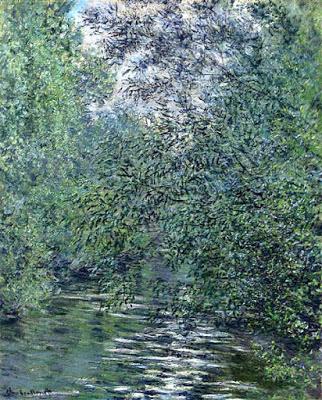
The Willows on the River by Claude Monet
In yesterday’s post The Benefits of Distraction: Tetris vs. Yoga, I wrote that yoga was a better alternative than Tetris (and other similar forms of distraction) for getting into a flow state to help with anxiety, worry, and other negative emotions. But how exactly do you use yoga for this purpose? With meditation and pranayama, obviously you just practice as you normally would. But how would you achieve this state with your asana practice? Can you just do any asana practice at all? Or, are there some basic requirements that you will need to meet?Yeah, I’m sure you’ve figured out by now that you can’t just quickly run through a random set of poses while watching TV. But the basic requirements—as I figure it—are not too demanding:1. Practice at the right level of challenge for you.2. Practice mindfully, with a mental focus.Let’s take a closer look at both of these requirements.Practicing at the Right Level for YouThere needs to be some level of challenge in your practice if you want to achieve flow. Ram put it this way:“When one is engaged in an activity where the challenge matches the individual’s skill, that is, when a person's skills are fully involved in overcoming a challenging task.”So, while there is a time and place for doing restorative yoga or just enjoying your favorite basic poses, a super comfy, easy practice won’t engage your mind completely. (The only caveat to this being that if you did those practices with your mind well focused on your breath, that would might also work. But, remember, the goal here is "distraction" and "flow" not just physical relaxation.)On the other hand, if your practice is too challenging (something we don’t recommend doing anyway) that will lead more to frustration than flow.In fact, in the study A better distraction: Exploring the benefits of flow during uncertain waiting periods. discussed briefly yesterday, they tested the subjects with three different levels of Tetris: very easy, very challenging, and just challenging enough. So, we’re basically in Goldilocks territory, with you yourself needing to figure out what kind of practice is “just right” for you. And you might have to do some testing, as Goldilocks did. But, if you haven’t read our post How to Stay Safe While Practicing Yoga, you should check that out. Because you definitely want to follow those guidelines to help you know when you should back off on the challenging poses or practices.Finding a Mental FocusWhile there are many benefits you can get from practicing yoga poses with a wandering mind or one that is distracted by music, radio, or TV, to get into a flow state you need to do your poses mindfully, which requires both concentration and practicing without self judgment. There are many different ways to practice asanas mindfully, so, again, like Goldilocks, you may need to experiment to see what engages your mind the best. And, in fact, you may need to change up what you do, as doing it the same way will probably create a routine quality that begins to bore you a bit.For general information on practicing yoga mindfully, see Practicing Yoga Mindfully. In this post, you can learn about how Jon Kabat-Zinn recommends practicing yoga poses mindfully.For information on how to practice breath awareness, which is always a good way to have a mental focus in just about any pose, see A Balm for the Soul: Practicing Simple Breath Awareness. If you're stuck in a rut with the way you currently practice breath awareness or if doing so makes you anxious, check out this post for ideas of other ways to do it.For information on various ways to use your seven senses as a point of focus, see Coming to Your Senses in Yoga Poses. If you haven't read this post, you may be surprised to learn how many senses we actually have and what a variety of ways there are to use them as we practice.Subscribe to Yoga for Healthy Aging by Email ° Follow Yoga for Healthy Aging on Facebook and Twitter ° To order Yoga for Healthy Aging: A Guide to Lifelong Well-Being, go to Amazon, Shambhala, Indie Bound or your local bookstore.For information about Nina's upcoming book signings and other activities, see Nina's Workshops, Book Signings, and Books.
